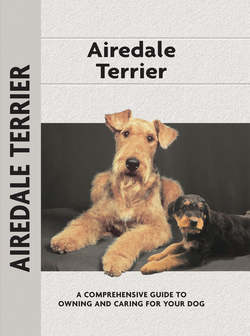Читать книгу Airedale Terrier - Bardi McLennan - Страница 9
На сайте Литреса книга снята с продажи.
A STANDARD, OF SORTS
ОглавлениеThe first breed standard with a scale of points was written in 1879 by Reginald Knight of Leeds and based entirely on his dog, Thunder, whom he considered to be almost perfect. Great controversy ensued and a second standard and points scale were drawn up by a group of breeders who felt that, despite Mr. Knight’s understandable devotion to Thunder, there was still much work required to bring the breed to anything like their idea of perfection.
Matador Mandarin was a British champion from the 1930s who, supposedly, was purchased for a few shillings as a pet and later went on to win many show awards.
A dog named Colne Crack was among the first thought to be without most of the undesirable houndlike features. A bitch by Crack and out of Poll was named Fracture. (You begin to see how “specific” this background information is.) Fracture is described as having a soft coat and bad ears, but nevertheless did some early winning. The leading stud dog of the day was Rover III, whelped in 1881. He sired several champions, including Venus III and Vixen III. Another, Cholmondeley Bondsman, is best known for having been sold for 100 guineas, an outrageous sum in that era. Things were looking up for the new breed.
This is believed to be the first published illustration of an Airedale: Thunder, owned by R. Knight, drawn in 1878.
Eng. Ch. Cotsford Topsail, noted for having a remarkable head, is shown here perfectly trimmed in the preferred style of the 1930s.
However, a dog named simply Airedale Jerry is felt to be the first of the breed as we would recognize it today. We do know how Jerry came about. A dog named Bruce sired Eng. Ch. Brush (before Bruce was sent off to America in 1881) and Brush’s daughter, Bess, was bred to Rattler to produce Jerry in 1888.
Jerry was bred to Cholmondeley Luce, a mating that produced another great one, Cholmondeley Briar, a top dog in his lifetime. Briar was the only pup in his litter to survive. Another example of the name-change-syndrome: Briar was entered as Red Robin at the Bingley show, where he took first prize at the age of six months and at which time he was sold and his name changed. Briar went on to win 100 consecutive firsts and was considered by many to be the “father of the breed,” a designation given to several of the first top sires. Among the bitches that did well was Luce (also called Miss Luce), whose next litter became all first-prize winners and all but one in her third litter repeated this feat.
Briar, mated to an Eng. Ch. Newbold Test daughter, Rosamond, sired Briar Test, a dog considered for type to be an even more dominant “father of the breed.” Test’s son, Master Briar, bred to a daughter of Holland Buckley’s Clonmel Marvel, produced Eng. Ch. Clonmel Monarch. Eng. Ch. Warland What Not and Int. Ch. Warland Ditto were two from J. P. Hall’s kennels that were held to be exceptional. Ditto’s get figured prominently in England, on the Continent and in the United States.
